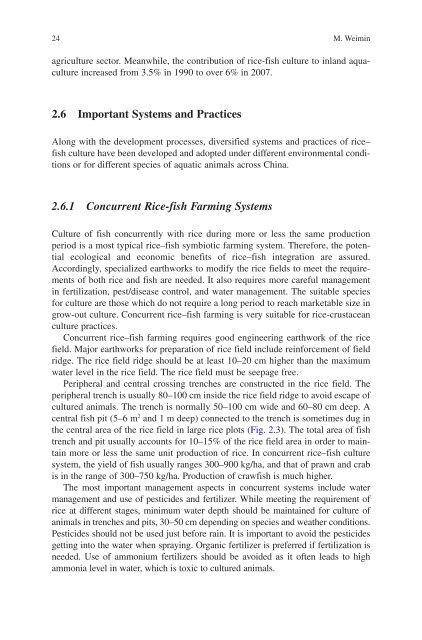Success Stories In Asian Aquaculture - Library - Network of ...
Success Stories In Asian Aquaculture - Library - Network of ...
Success Stories In Asian Aquaculture - Library - Network of ...
- No tags were found...
Create successful ePaper yourself
Turn your PDF publications into a flip-book with our unique Google optimized e-Paper software.
24 M. Weiminagriculture sector. Meanwhile, the contribution <strong>of</strong> rice-fish culture to inland aquacultureincreased from 3.5% in 1990 to over 6% in 2007.2.6 Important Systems and PracticesAlong with the development processes, diversified systems and practices <strong>of</strong> rice–fish culture have been developed and adopted under different environmental conditionsor for different species <strong>of</strong> aquatic animals across China.2.6.1 Concurrent Rice-fish Farming SystemsCulture <strong>of</strong> fish concurrently with rice during more or less the same productionperiod is a most typical rice–fish symbiotic farming system. Therefore, the potentialecological and economic benefits <strong>of</strong> rice–fish integration are assured.Accordingly, specialized earthworks to modify the rice fields to meet the requirements<strong>of</strong> both rice and fish are needed. It also requires more careful managementin fertilization, pest/disease control, and water management. The suitable speciesfor culture are those which do not require a long period to reach marketable size ingrow-out culture. Concurrent rice–fish farming is very suitable for rice-crustaceanculture practices.Concurrent rice–fish farming requires good engineering earthwork <strong>of</strong> the ricefield. Major earthworks for preparation <strong>of</strong> rice field include reinforcement <strong>of</strong> fieldridge. The rice field ridge should be at least 10–20 cm higher than the maximumwater level in the rice field. The rice field must be seepage free.Peripheral and central crossing trenches are constructed in the rice field. Theperipheral trench is usually 80–100 cm inside the rice field ridge to avoid escape <strong>of</strong>cultured animals. The trench is normally 50–100 cm wide and 60–80 cm deep. Acentral fish pit (5–6 m 2 and 1 m deep) connected to the trench is sometimes dug inthe central area <strong>of</strong> the rice field in large rice plots (Fig. 2.3 ). The total area <strong>of</strong> fishtrench and pit usually accounts for 10–15% <strong>of</strong> the rice field area in order to maintainmore or less the same unit production <strong>of</strong> rice. <strong>In</strong> concurrent rice–fish culturesystem, the yield <strong>of</strong> fish usually ranges 300–900 kg/ha, and that <strong>of</strong> prawn and crabis in the range <strong>of</strong> 300–750 kg/ha. Production <strong>of</strong> crawfish is much higher.The most important management aspects in concurrent systems include watermanagement and use <strong>of</strong> pesticides and fertilizer. While meeting the requirement <strong>of</strong>rice at different stages, minimum water depth should be maintained for culture <strong>of</strong>animals in trenches and pits, 30–50 cm depending on species and weather conditions.Pesticides should not be used just before rain. It is important to avoid the pesticidesgetting into the water when spraying. Organic fertilizer is preferred if fertilization isneeded. Use <strong>of</strong> ammonium fertilizers should be avoided as it <strong>of</strong>ten leads to highammonia level in water, which is toxic to cultured animals.
















